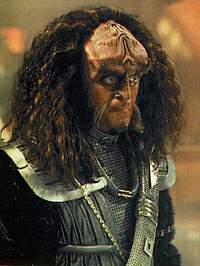
For more information, click here and here.
People
Humanoid warrior civilization, originally from the planet Qo'noS; a proud, tradition-bound
people who value honor. The aggressive Klingon culture has made them an interstellar
military power to be respected and feared. There is no equivalent of the devil
in Klingon mythology, although a beast known as Fek'lhr is believed to guard
the underworld of Gre'thor. According to myth, ancient Klingon warriors slew
their gods a millennium ago. They apparently were more trouble than they were
worth. Perhaps this is why the Klingons have no devil; they killed him. In Klingon
society, the death of a warrior who has died honorably in battle is not mourned.
In such cases, the survivors celebrate the freeing of the spirit. Klingons believe
in an afterlife but there is no burial ceremony. They dispose of the body in
the most efficient means possible, confident that the warrior's spirit has now
joined Kahless the Unforgettable in Sto-Vo-Kor. Klingon tradition holds that
"the son of a Klingon is a man the day he can first hold a blade."
Another Klingon ritual is the R'uustai, or bonding ceremony, in which two individuals
join families, becoming brothers and sisters. Klingons believe that they have
the instinctive ability to look an opponent in the eye and see the intent to
kill. Klingon tradition holds that a Klingon who dies by their own hand will
not travel across the River of Blood to enter Sto-Vo-Kor. If a Klingon warrior
strikes another with the back of his hand, it is interpreted as a challenge
to the death. Klingon warriors speak proudly to each other; they do not whisper
or keep their distance. Standing far away or whispering are considered insults
in Klingon society.
The Klingon body incorporates multiple redundancies for nearly all vital bodily
functions. This characteristic, known as brak'lul, gives Klingon warriors enormous
resiliency in battle. Despite the considerable sophistication of Klingon technology,
significant gaps exist in Klingon medical science, in part due to cultural biases
that injured warriors should be left to die or to carry out the Hegh'bat. Klingons
have redundant stomachs. Klingons have no tear ducts. Klingon blood is a lavender-colored
fluid.
Klingons are a warrior
race who hold personal and family honor above all else. They are larger than
Terrans with a greater percentage of their body weight being muscle. Klingons
are proficient in the use of ritual hand-to-hand weapons and unarmed combat,
and will actually prefer to fight using these methods over beam weapons. They
frequently train in off-hand weapons training in order to surprise opponents.
All Klingons will train in at least the bat'telh and the d'k tahg, and many
frequently train in some of the other ceremonial Klingon weapons. Some also
train in Mok'bara - the Klingon martial art form.
The Klingon forehead
is a major distinguishing feature of this race, consisting of a ridged, bony
pattern. This pattern is different for every Klingon, and is as distinguishing
as fingerprints. A common curse heard among them is: "Hab Sosil' Quch",
which means, "Your mother has a smooth forehead." Also, a bony backbone
resembling that of a dinosaur runs up and down their spine. Klingons
have enhanced senses. Two of them, acute taste and smell, and acute vision,
are genetic, but the third, combat reflexes, is learned from childhood, and
is therefore second nature to Klingons. By nature, they are hunters, and still
practice the ritual of the hunt. They are taught tracking and cooking from a
very early age. They hunt using a spear called a Gin'tak. They prefer their
food raw, so the Cooking skill actually represents the ability to properly clean
their food and prepare it in a traditional manner.
Most Klingons feel it is dishonorable to lie, cheat, steal, or bluff, and dislike those who do. This helps explain their dislike of Ferengi. Klingons are now blood enemies of the Romulans, despite (or perhaps -on account of-) their former treaties with them.
Klingon warriors pride themselves on their combat abilities and feel the greatest honor that can be bestowed on warriors is to die in combat. These traits have been handed down from the Klingon spiritual leader, Kahless, over two millennia ago. Kahless used the idea of honor to unite the people of the Klingon Homeworld at a time of its greatest struggle.
Also handed down were several traditional weapons with which to engage in melee.
Lastly, almost all Klingons
show a widespread hatred of the cute, cuddly Tribble. Currently, xenoculturalists
are unable to account for the source of this hatred. Tribbles are banned from
being transported to, or traded in, Klingon space. An old Klingon toast reflects
their dislike of this animal. It goes: "QuvlIjDaq yIH tu'be'lu'jaj."
Translated, this means, "May your coordinates be free of Tribbles."
Tribbles also share
the dislike of Klingons. Instead of the usual purr, Tribbles will shriek if
even exposed to a Klingon.
Klingon homeworld
The capital planet of the Klingon Empire. A large, green, Class-M world, the
homeworld was rarely referred to by its formal name, Qo'noS (pronounced kronos).
The Enterprise-D visited the planet in 2366 when Worf challenged the High Council
ruling that his father, Mogh, was a traitor. The ship visited the homeworld
again in late 2367 when Jean-Luc Picard attended the installation of Gowron
as High Council leader. Picard had served as Gowron's Arbiter of Succession.
The Enterprise-D again returned to the Klingon Homeworld a few weeks later,
when Picard requested the loan of a Klingon bird-of-prey for a covert mission
into Romulan space to investigate the disappearance of Ambassador Spock.